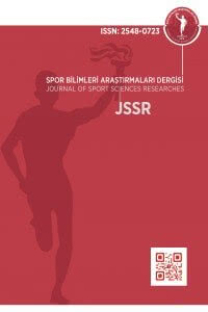Tenisçilerde Çeviklik Yeteneğinin Yaş Faktörüne Göre Karşılaştırılması ve Tenis Performansı İle İlişkisinin Araştırılması
Tenis, Çeviklik, Klasman, Performans
Comparison of Agility by Age Factor and Investigation of Relationship with Tennis Performance
Tennis, Agility, Ranking, Performance,
___
- Agricola, A., Zhanel, J. & Hubáček, O. (2013). Relative age effect in junior tennis (male). Acta Univsitatis Palackianae Olomucensis, 43(1), 27-33. Doi: 10.5507/ag.2013.003
- Armstrong, R. & Greig, M. (2018). The functional movement screen and modified star excursion balance test as predictors of t-test agility performance in university rugby union and netball player. Physical Therapy in Sport, 31, 15-21. Doi: 10.1016/j.ptsp.2018.01.003
- Arpak, M. (2019). Genç basketbolcuların çeviklik, vücut kompozisyonu ve RAST test ölçümlerinin incelenmesi. Yayınlanmamış Yüksek Lisans Tezi. Yıldırım Beyazıt Üniversitesi, Sağlık Bilimleri Enstitüsü, Ankara.
- Ateş, B. (2018). Age-related effects of speed and power on agility performance of young soccer players. Journal of Education and Learning, 6(7), 93-99. Doi:10.5539/jel.v7n6p93
- Can, İ., Cihan, H., İmamoğlu, R., Albayrak, A. Y. & Arı, E. (2013). Changes in the athletic performances of soccer players from pre and post training. The 4th International Conference on Sports and Exercise Science: Well-Being Well Beyond Sport and Exercise, Bangkok / Tailand.
- Chelladurai, P. (1976). Manifestations of agility. Journal of the Canadian Association of Health Physical Education and Recreation, 42(3), 4-36.
- Çömük, N. ve Erden, Z. (2010). Artistik buz pateninde üçlü sıçrayış performansının çeviklik ve reaksiyon zamanı ile ilişkisi. Fizyoterapi Rehabilitasyon, 21(2), 75-80.
- Draper, J.A. & Lancaster, M.G. (1985). The 505 test: A test for agility in the horizontal plane. Australian Journal for Science and Medicine in Sport, 17(1), 15-18.
- Filipčič, A. & Filipčič, T. (2006). Analysis of time and game characteristics in top profile tennis. Acta Universitatis Carolinae: Kinanthropologica, 41(1), 41-53.
- Gambetta, V. (1996). How to develop sport specific speed. Sports Coach, 19(3), 22-24.
- Groppel, J.L. & Roetert, E.P. (1992). Applied physiology of tennis. Sports Medicine, 14(4), 260-268. Doi: 10.2165/00007256-199214040-00004
- Karacabey, K. (2013). Sporda performans ve çeviklik testleri. International Journal of Human Sciences, 10(1), 1693-1704.
- Kovacs, M.S. (2006). Applied physiology of tennis performance. British Journal of Sports Medicine, 40(5), 381-386. Doi: 10.1136/bjsm.2005.023309
- Kramer, T., Huijgen, B.C., Gemser, M.T. & Visscher, C. (2017). Prediction of tennis performance in junior elite tennis players. Journal of Sports Science and Medicine, 16(1), 14-21.
- McPherson, S.L. & Thomas, J. (1989). Relation of knowledge and performance in boys' tennis: Age and expertise. Journal of Experimental Child Psychology, 48(2), 190-211. Doi: 10.1016/0022-0965(89)90002-7
- Mondal, S. & Kumar, P. (2015). Comparison of flexibility and agility of table tennis players and badminton players in school students. National Journal of Physical Education and Sport Science, 2(1), 81-83.
- O'Donoghue, P.G. & Ingram, B. (2001). A notational analysis of elite tennis strategy. Journal of Sports Science, 19(2), 107-115. Doi: 10.1080/026404101300036299
- Okudur, A. ve Sanioğlu, A. (2012). 12 yaş tenisçilerde denge ile çeviklik ilişkisinin incelenmesi. Selçuk Üniversitesi Beden Eğitimi ve Spor Bilim Dergisi, 14(2), 165-170.
- Özdemir, F.M. (2013). Genç futbolcularda çeviklik, sürat, güç ve kuvvet arasındaki ilişkinin yaşa göre incelenmesi. Yayınlanmamış Yüksek Lisans Tezi. Başkent Üniversitesi, Sağlık Bilimleri Enstitüsü, Ankara.
- Parsons, L.S. & Jones, M. (1998). Development of speed, agility and quickness for tennis athletes. Strength and Conditioning Journal, 20(3), 14-19.
- Roetert, E.P., Piorkowski, P.A., Woods, R.B. & Brown, S.W. (1995). Establishing percentiles for junior tennis players based on physical fitness testing results. Clinics in Sports Medicine 14(1), 1-21. Doi: 10.1016/S0278-5919(20)30254-4
- Sheppard, J.M. & Young, W.B. (2006). Agility literature review: Classifications, training and testing. Journal of Sport Sciences, 24(9), 919-932. Doi: 10.1080/02640410500457109
- Smekal, G., Pokan, R., Duvillard, S.P., Baron, R., Tschan, H. & Bachl, N. (2000). Comparison of laboratory and “on-court” endurance testing in tennis. International Journal of Sports Medicine, 21(4), 242-249. Doi: 10.1055/s-2000-310
- Türkiye Tenis Federasyonu (2014). Türkiye Tenis Federasyonu Klasman Talimatı. https://www.ttf.org.tr/images/talimatlar/2014/763432014%20TTF%20M%C3%BCsabaka%20ve%20Klasman%20Talimat%C4%B1.pdf
- Twist, P.W. & Benicky, D. (1995). Conditioning lateral movements for multisport athletes: Practical strength and quickness drills. Strength and Conditioning Journal, 17(5), 43-45.
- Young, W., McDowell, M. & Scarlet , B. (2001). Specificity of sprint and agility training method. Journal of Strength and Conditioning Research, 15(3), 315-319. Doi: 10.1519/1533-4287(2001)015<0315:sosaat>2.0.co;2
- Young, W.B. & Farrow, D. (2006). A review of agility: Practical applications for strength and conditioning. National Strength and Conditioning Association, 28(5), 24-29. Doi:10.1519/00126548-200610000-00004
- Zemkova, E. (2016). Differential contribution of reaction time and movement velocity to the agility performance reflects sport-specific demands. Human Movement, 17(2), 94-101. Doi: 10.1515/humo-2016-0013
- ISSN: 2548-0723
- Yayın Aralığı: 3
- Başlangıç: 2016
- Yayıncı: Kadir YILDIZ
Ortaokul Öğrencilerinin Beden Eğitimi Öğretmenlerine Yönelik Metaforlarının İncelenmesi
Büşra CİRİT, Sebiha GÖLÜNÜK BAŞPINAR
Beden Eğitimi ve Öğretim Temalı Doktora Tezlerine İlişkin Bibliyometrik Analiz
Hüseyin Şahin UYSAL, Emrah ATAY
Antrenörlerin Meslek Etiği Davranışlarına İlişkin Antrenör ve Sporcu Görüşleri
Hediye KANTEKİN, Serkan ÖZGÜR, TUNCAY VAROL
Dış Mekân Spor Aletlerinin Fiziksel Aktivite, Sağlık ve Ergonomik Açıdan Değerlendirilmesi
